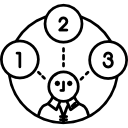Iteration: Difference between revisions
Mr. MacKenty (talk | contribs) No edit summary |
Mr. MacKenty (talk | contribs) No edit summary |
||
| Line 3: | Line 3: | ||
In computer programming, iteration is a sequence of instructions that is continually repeated. You can think of iteration as a loop, but please use the word "iteration" or "iterate" in this class. | In computer programming, iteration is a sequence of instructions that is continually repeated. You can think of iteration as a loop, but please use the word "iteration" or "iterate" in this class. | ||
There are different | There are different types of iterations: | ||
# iterate until a certain condition is reached | # iterate until a certain condition is reached | ||
# iterate a certain number of times | # iterate a certain number of times | ||
# iterate through elements in a list or array | # iterate through elements in a list or array | ||
When we iterate we | When we iterate we change something a little bit each time we iterate. If I am iterating 100 times, our programing language will keep track of '''which iteration''' we are cycling through. For example, we might get an item of data and change it. Or, we might check if some condition such as whether a counter has reached a prescribed number. | ||
If it hasn't, the next instruction in the sequence is an instruction to return to the first instruction in the sequence and repeat the sequence. If the condition has been reached, the next instruction "falls through" to the next sequential instruction or branches outside the loop. A loop is a fundamental programming idea that is commonly used in writing programs. | If it hasn't, the next instruction in the sequence is an instruction to return to the first instruction in the sequence and repeat the sequence. If the condition has been reached, the next instruction "falls through" to the next sequential instruction or branches outside the loop. A loop is a fundamental programming idea that is commonly used in writing programs. | ||
Revision as of 12:29, 18 June 2019
In computer programming, iteration is a sequence of instructions that is continually repeated. You can think of iteration as a loop, but please use the word "iteration" or "iterate" in this class.
There are different types of iterations:
- iterate until a certain condition is reached
- iterate a certain number of times
- iterate through elements in a list or array
When we iterate we change something a little bit each time we iterate. If I am iterating 100 times, our programing language will keep track of which iteration we are cycling through. For example, we might get an item of data and change it. Or, we might check if some condition such as whether a counter has reached a prescribed number.
If it hasn't, the next instruction in the sequence is an instruction to return to the first instruction in the sequence and repeat the sequence. If the condition has been reached, the next instruction "falls through" to the next sequential instruction or branches outside the loop. A loop is a fundamental programming idea that is commonly used in writing programs.
An infinite loop is one that lacks a functioning exit routine. The result is that the loop repeats continually until the operating system senses it and terminates the program with an error or until some other event occurs (such as having the program automatically terminate after a certain duration of time) [1].
Introduction[edit]
This is one of the better videos I've seen on loops. Content gratefully used with permission : [2]. The video uses programming syntax from the C programming language, but the main ideas are helpful in understanding loops.
A good video[edit]
Standards[edit]
- Construct algorithms using loops, branching.
